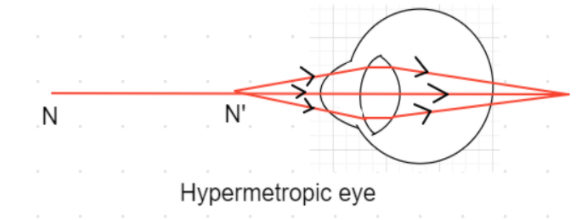
What is hypermetropia? What are the possible reasons for hypermetropia? How is hypermetropia corrected? Explain with figures.
Answer
580.2k+ views
Hint: Here, we will proceed by defining the eye defect hypermetropia or farsightedness. Then, we will mention various reasons for its cause. Then, we will correct this eye defect by using a converging lens with the help of figures.
Complete step-by-step answer:



A person suffering from hypermetropia can clearly see distinct objects but faces difficulty in clearly seeing surrounding objects. This is because the eye lens focuses the incoming divergent rays beyond the retina. This vision defect is corrected by the use of a convex lens. The incoming light converges in such a way that the image is created on the retina with a convex lens of sufficient intensity. This is also known as farsightedness.
It's a refractive error that clearly displays distant objects, however near objects seem blurred. People perceive farsightedness differently and some people don't have any issues with their vision, most generally when they are young.Therefore, vision for objects at any point, close or far, can be blurred for people with extreme farsightedness.
Diverse possible explanations for hypermetropic are given as follows:
The human eye requires two vital components to focus on an image that is cornea (which is the eye's clear front surface) and crystalline lens (a clear structure inside the eye that changes shape to focus on objects).
Such focusing components have a smooth curvature in an eye without refractive error, much like the surface of a smooth rubber ball, and bend incoming light to form a sharply centered image on the retina.
Correction of hypermetropia:
Farsightedness or hypermetropia describes the eye's inability to focus on nearby objects. This can be seen from the figure, the farsighted eye has no difficulties in seeing distant objects. The lens can no longer take for granted the convex and curved form lens required to view nearby objects. This issue of vision can be solved using a converging lens, as seen in the figure.
Until reaching the eye it will refract light and gradually decrease the distance of the image. By initializing the process of refraction before light enters the eye and the image of nearby objects is again centered on the surface of the retina.
With the eyeball shortening the retina lies closer to the cornea and lens than normal. This means images of nearby objects beyond the retina are created. Again the same converging lens is needed to correct this problem.
Note: Farsightedness is seen mainly in adults, and rarely in children. When this problem of vision happens among teenagers, the cause will probably be linked to the lens' inability to assume short focal length. The problem in this case relates more to a shortened eyeball.
Complete step-by-step answer:



A person suffering from hypermetropia can clearly see distinct objects but faces difficulty in clearly seeing surrounding objects. This is because the eye lens focuses the incoming divergent rays beyond the retina. This vision defect is corrected by the use of a convex lens. The incoming light converges in such a way that the image is created on the retina with a convex lens of sufficient intensity. This is also known as farsightedness.
It's a refractive error that clearly displays distant objects, however near objects seem blurred. People perceive farsightedness differently and some people don't have any issues with their vision, most generally when they are young.Therefore, vision for objects at any point, close or far, can be blurred for people with extreme farsightedness.
Diverse possible explanations for hypermetropic are given as follows:
The human eye requires two vital components to focus on an image that is cornea (which is the eye's clear front surface) and crystalline lens (a clear structure inside the eye that changes shape to focus on objects).
Such focusing components have a smooth curvature in an eye without refractive error, much like the surface of a smooth rubber ball, and bend incoming light to form a sharply centered image on the retina.
Correction of hypermetropia:
Farsightedness or hypermetropia describes the eye's inability to focus on nearby objects. This can be seen from the figure, the farsighted eye has no difficulties in seeing distant objects. The lens can no longer take for granted the convex and curved form lens required to view nearby objects. This issue of vision can be solved using a converging lens, as seen in the figure.
Until reaching the eye it will refract light and gradually decrease the distance of the image. By initializing the process of refraction before light enters the eye and the image of nearby objects is again centered on the surface of the retina.
With the eyeball shortening the retina lies closer to the cornea and lens than normal. This means images of nearby objects beyond the retina are created. Again the same converging lens is needed to correct this problem.
Note: Farsightedness is seen mainly in adults, and rarely in children. When this problem of vision happens among teenagers, the cause will probably be linked to the lens' inability to assume short focal length. The problem in this case relates more to a shortened eyeball.
Recently Updated Pages
Master Class 12 English: Engaging Questions & Answers for Success

Master Class 12 Business Studies: Engaging Questions & Answers for Success

Master Class 12 Economics: Engaging Questions & Answers for Success

Master Class 12 Social Science: Engaging Questions & Answers for Success

Master Class 12 Maths: Engaging Questions & Answers for Success

Master Class 12 Chemistry: Engaging Questions & Answers for Success

Trending doubts
What are the major means of transport Explain each class 12 social science CBSE

Which are the Top 10 Largest Countries of the World?

Draw a labelled sketch of the human eye class 12 physics CBSE

Explain sex determination in humans with line diag class 12 biology CBSE

Explain sex determination in humans with the help of class 12 biology CBSE

Differentiate between homogeneous and heterogeneous class 12 chemistry CBSE




